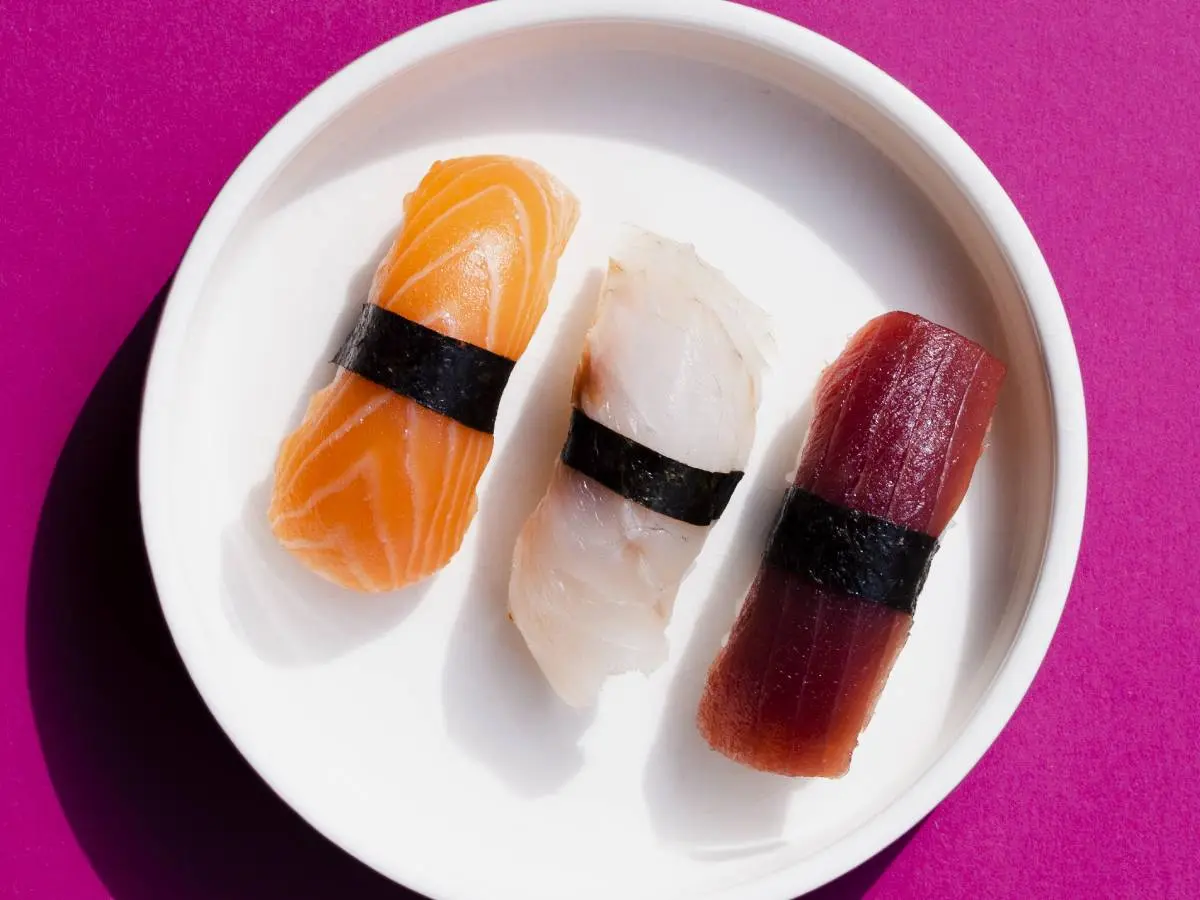What are the three ingredients in sushi? – Diving into the world of sushi is like embarking on a culinary adventure that tantalizes the taste buds and introduces the palate to a symphony of flavors and textures. Sushi, a dish that has transcended its Japanese origins to become a global favorite, is much more than just food; it’s an art form that combines simplicity with complexity, tradition with innovation. In this comprehensive guide, we’ll peel back the layers of sushi, exploring the essential ingredients that make up this beloved dish, offering insights into preparing sushi at home, and answering some of the most common questions that sushi enthusiasts and novices alike may have. So, grab your chopsticks, and let’s dive into the delicious world of sushi!

Introduction to Sushi
Understanding Sushi: A Culinary Art
Sushi, with its humble beginnings as a method of preserving fish in fermented rice, has evolved dramatically over the centuries. Today, it stands as a testament to the elegance of Japanese cuisine, celebrated for its emphasis on quality, seasonality, and presentation. At its core, sushi is a simple dish, yet it’s this simplicity that belies its profound complexity and depth.
The journey of sushi from a method of preservation to a culinary art form is nothing short of fascinating. Originally, the rice used in sushi was discarded, and only the fish was consumed. However, as sushi made its way into the mainstream of Japanese cuisine, the rice became an integral part of the dish, seasoned with vinegar and combined with various ingredients to create the sushi we know and love today.
The significance of sushi in Japanese culture cannot be overstated. It’s a dish that embodies the Japanese aesthetic of wabi-sabi, the beauty of imperfection, and omotenashi, the spirit of selfless hospitality. Sushi chefs spend years, sometimes decades, mastering the art of sushi making, a testament to the dedication and passion that goes into every piece of sushi.
As we delve deeper into the world of sushi, we’ll explore the three pillars that form the foundation of this exquisite dish: sushi rice (sushi-meshi), nori (seaweed), and fresh fish. Each ingredient plays a crucial role in sushi’s flavor profile and texture, and understanding these components is key to appreciating the art of sushi.
So, whether you’re a seasoned sushi aficionado or a curious newcomer eager to explore the depths of this culinary tradition, join us on this journey through the heart of sushi. Together, we’ll discover the secrets behind the ingredients that make sushi a global phenomenon and learn how to bring the magic of sushi into our own kitchens.
Core Ingredients of Sushi
The Essential Trio: Rice, Nori, and Fresh Fish
At the heart of every sushi roll, nigiri, or sashimi lies a trio of ingredients that define this iconic dish. Understanding these components is crucial for anyone looking to appreciate or prepare sushi. Let’s dive into the essentials: sushi rice, nori, and sushi grade fish.
Sushi Rice (Sushi-Meshi)
Sushi without sushi rice is like a canvas without paint—it simply cannot exist. Sushi rice isn’t just any rice; it’s a special short-grain variety known for its ability to stick together, making it the perfect base for sushi. The process of preparing sushi rice is an art in itself, involving careful washing, soaking, and cooking to achieve the perfect texture.
But what truly sets sushi rice apart is the seasoning—a delicate blend of rice vinegar, sugar, and salt. This mixture is gently folded into the cooked rice, giving sushi its distinctive tangy flavor that complements the freshness of the fish. The art of seasoning sushi rice is a skill that sushi chefs refine over years of practice, ensuring that each grain of rice contributes to the overall harmony of the dish. Spicy tomato and seafood paella recipe
Nori: The Seaweed Wrapper
Nori, the green seaweed wrapper, is another indispensable ingredient in sushi, particularly in rolls like maki and temaki. High-quality nori should be crisp and have a slight oceanic flavor that doesn’t overpower the other ingredients. The color of nori can vary from a deep green to almost black, indicating its quality and flavor profile. Selecting the right nori is crucial, as it not only holds the sushi together but also adds texture and taste to the overall experience.
Sushi Grade Fish
The term sushi grade fish refers to the highest quality seafood, deemed safe and suitable for raw consumption. This includes a variety of fish and shellfish, each offering its own unique flavor and texture to sushi. Tuna, salmon, and yellowtail are among the most popular choices, known for their freshness and delicate taste.
When selecting sushi grade fish, freshness is paramount. Look for vibrant colors, a firm texture, and a clean smell. This ensures not only the safety of the sushi but also the best possible flavor experience. Understanding how to handle and prepare sushi grade fish is essential for anyone looking to make sushi at home.
In the world of sushi, the quality and preparation of these three core ingredients can make or break the dish. Each element, from the sticky grains of sushi rice to the fresh slices of fish, plays a vital role in creating the perfect bite of sushi. As we continue to explore the additional ingredients that enhance the flavors and textures of sushi, remember that at its core, sushi is a celebration of simplicity and quality. Salmon sushi bake
Preparing Sushi at Home
Step-by-Step Guide to Making Sushi
Making sushi at home might seem daunting at first, but with a bit of practice and the right ingredients, you can recreate the magic of sushi in your own kitchen. Here’s a simple guide to help you embark on your sushi-making journey, bringing the flavors of Japan to your dining table.
Basic Equipment Needed
Before diving into the art of sushi making, ensure you have the necessary tools. A bamboo rolling mat (makisu) is essential for rolling maki sushi, while a sharp knife is crucial for slicing fish and cutting rolls. Additionally, a rice cooker can simplify the process of cooking sushi rice, though it’s not strictly necessary.
Simple Sushi Recipes for Beginners
- Sushi Rice Preparation: Start by cooking your sushi rice according to package instructions. Once cooked, gently fold in a mixture of rice vinegar, sugar, and salt while the rice is still warm. Spread the rice on a wide plate or tray to cool down to room temperature.
- Maki Rolls: Begin with maki rolls, which are easier to master. Place a sheet of nori on your bamboo mat, spread an even layer of sushi rice on the nori, leaving a small margin at the top. Lay your fillings (sliced fish, cucumber, avocado, etc.) in a line at the bottom of the rice. Roll the bamboo mat away from you, applying gentle pressure to form a tight roll. Use a sharp, wet knife to cut the roll into bite-sized pieces.
- Nigiri: Nigiri requires a bit more finesse. Shape a small amount of sushi rice into an oblong mound with your hands. Slice a piece of sushi grade fish and gently press it onto the rice. A dab of wasabi between the rice and fish can add an extra kick.
- Sashimi: If you prefer something simpler, sashimi is a great option. Select high-quality sushi grade fish, and slice it against the grain into thin pieces. Serve with soy sauce, wasabi, and pickled ginger on the side.
Making sushi at home is not just about the end product; it’s about enjoying the process and experimenting with different flavors and techniques. Don’t worry if your rolls aren’t perfect at first—sushi making is an art that takes time to master. Remember, the key to great sushi is using the freshest ingredients and handling them with care. So, roll up your sleeves, and let’s bring the sushi bar to your kitchen!
FAQs
Frequently Asked Questions
Embarking on your sushi-making journey can raise many questions. Here are answers to some of the most common queries to help demystify the process and enhance your sushi experience.
What makes sushi rice different from regular rice?
Sushi rice is made from a specific variety of short-grain rice known for its sticky texture when cooked. This stickiness is essential for sushi, as it holds the ingredients together. What truly sets sushi rice apart, however, is the seasoning—a blend of rice vinegar, sugar, and salt. This combination gives sushi its distinctive tangy flavor, balancing the richness of the fish and other ingredients.
Can I make sushi without Nori?
Absolutely! While nori is a common ingredient in rolls, sushi can be made without it. Nigiri, for example, consists of a slice of fish atop a mound of sushi rice, with no nori in sight. Additionally, there are many creative ways to make sushi, such as using thinly sliced cucumber as a wrap or even forming sushi into balls or squares without any seaweed.
Is it safe to make sushi with any fish?
Not all fish is safe to consume raw due to the risk of parasites and bacteria. It’s crucial to use sushi grade fish, which has been handled and frozen in a way that makes it safe for raw consumption. When in doubt, always ask your fishmonger for sushi-grade options and store the fish properly until you’re ready to make your sushi.


